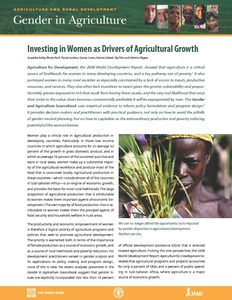Investing in women as drivers of agriculture
Abstract
Agriculture for Development, the 2008 World Development Report, showed that agriculture is a critical source of livelihoods for women in many developing countries, and a key pathway out of poverty.1 It also portrayed women in many rural societies as especially constrained by a lack of access to inputs, productive resources, and services. They also often lack incentives to invest given the greater vulnerability and proportionately greater exposure to risk that result from having fewer assets, and the very real likelihood that once their niche in the value chain becomes commercially profitable it will be expropriated by men. The Gender and Agriculture Sourcebook uses empirical evidence to inform policy formulation and program design.2 It provides decision makers and practitioners with practical guidance, not only on how to avoid the pitfalls of gender neutral planning, but on how to capitalize on the extraordinary productive and poverty reducing potential of the woman farmer

